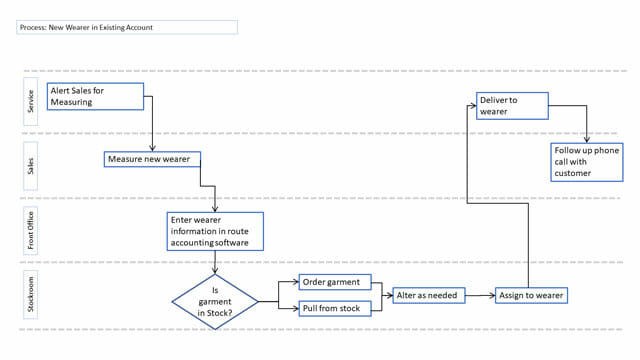Standard Operating Procedures: Key to Enhanced Performance

If you want to achieve continuous improvement for your linen, uniform and facility services company, a good place to start is developing Standard Operating Procedures (SOPs) and work instructions. The benefits of having SOPs in place include standardization, communication and clarity between departments, plus a regular process for training and onboarding new employees. SOPs also can help your company show customers that your quality system is sound. Another plus is that they can help staff meet qualifications for certification programs, such as Hygienically Clean.
Creating such documentation policies and procedures takes a concentrated effort both to develop and maintain SOPs and work instructions. Savvy operators will carefully weigh where they apply their efforts. Not all processes will need a procedure, but some critical and complex processes may need more than one. For many purposes, an SOP can include elements of both a high-level procedure (What and Who) with work instructions (How).
A template with fields for standard information is an important tool. It can provide a standardized thought process for anyone writing a procedure to follow. A basic template should include the following elements:
Title: What is the SOP documenting?
Scope: Specific departments, locations and workgroups that the SOP affects.
Responsible: Title of manager responsible for ensuring that the SOP is carried out. Be sure to use titles, not names of people (“Plant Manager” not “Jackie Smith”) in the documents.
Date: Include the date of the latest revision of the SOP. A rigorous revision-control protocol is to state that only the electronic version of the document is valid, and any printed copies are considered as potentially out of date. (This level of control is typically not needed if SOPs don’t change often, and if producing and managing hard copies is controlled.)
Purpose: How the procedure links to overall policies and its overall goal.
Signature/Approval: Optional, but good to have approved by manager to confirm that the procedure is correct.
Version Description: Optional. A short table describing historical dated changes to the SOP.
Procedure: The actual procedural description, which is the main body of the procedure.
When writing the procedure, use simple, straightforward language. Ideally, keep the language to an eighth-grade level, so most can understand it. There are readability calculators online that can help you check the grade level. Use photos and pictures to illustrate the correct way of doing things.
Using flow charts and diagrams is a good way to convey information concisely. I particularly like “swimlane” charts, which are perfect for showing hand-offs between departments. The swimlane chart can be used for high-level procedures (“Who” does “What”), and they can be supplemented with lower-level work instructions as needed for detailed explanation. For example, above is a swimlane chart showing the process for onboarding a new wearer for a garment program. Each block in the diagram could be further described with its own work instruction or perhaps a section of instruction in the same document, providing detail on how to perform that specific task.
Organizing the documented policies, SOPs and work instructions is important and can be challenging. Some companies create a numbering system based on departments; some number their SOPs to correspond to sections of the Hygienically Clean standard. The documents should be stored on a shared drive, with permissions to edit restricted to one or a few people. Others can be given read-only access, so they can use the SOPs in their daily work and with onboarding new employees. Finally, operators should establish a system for periodic review/renewal of the procedures – at least annually and have a system in place for anyone to suggest changes to the SOPs.
Creating and maintaining SOPs takes a commitment, but the benefits to your organization are great. A systematic process of documenting and refining SOPs is a great way to ensure enhanced performance in your operations.
A more detailed version of this article by Audrey Carmichael, a senior client consultant with Six Disciplines Consulting Services, Findlay, OH, is slated to appear in the March issue of Textile Services magazine. Click here for a recent interview with Carmichael on quality manuals. Readers may contact Carmichael at acarmichael@SixDConsulting.com.
